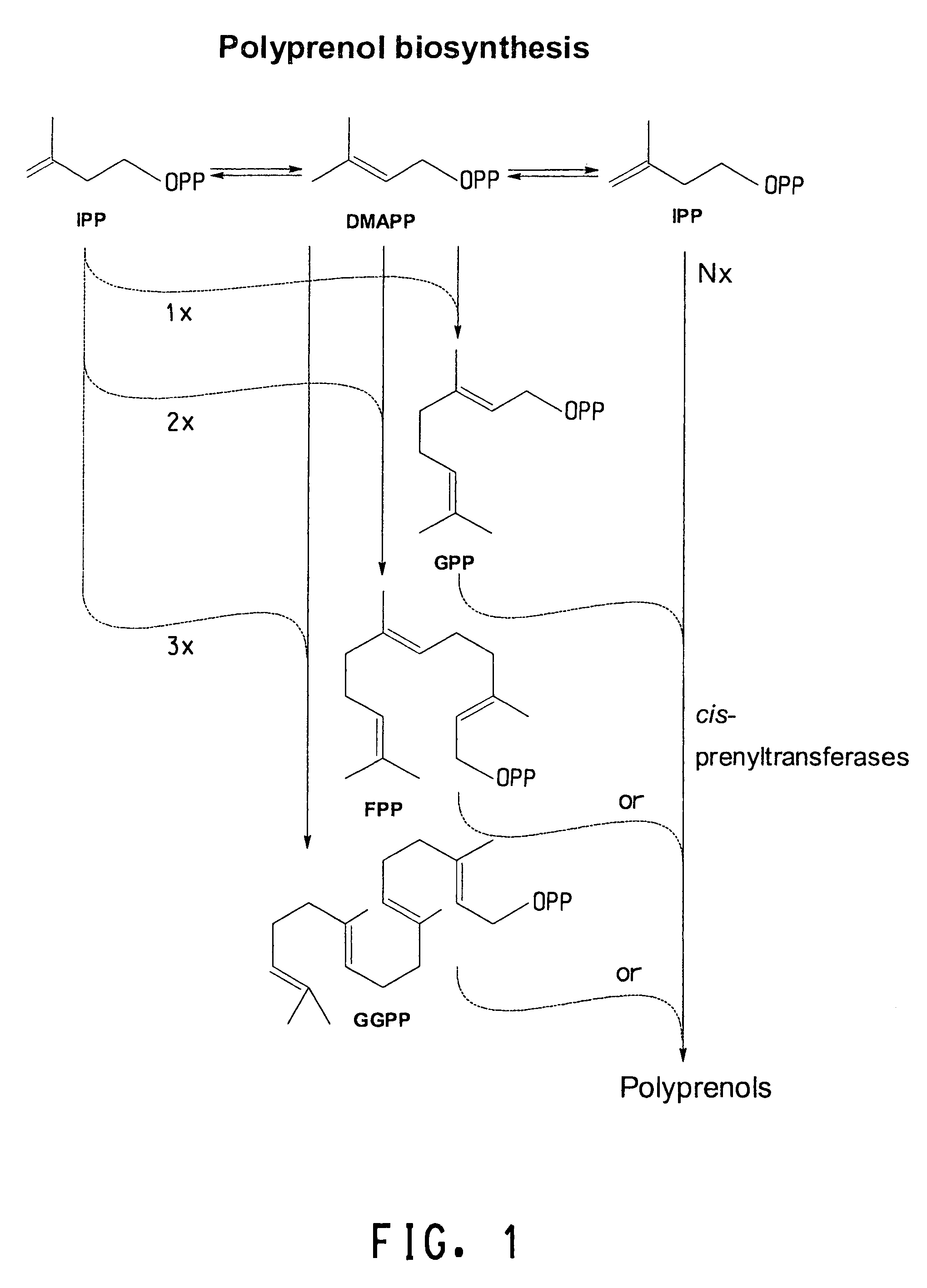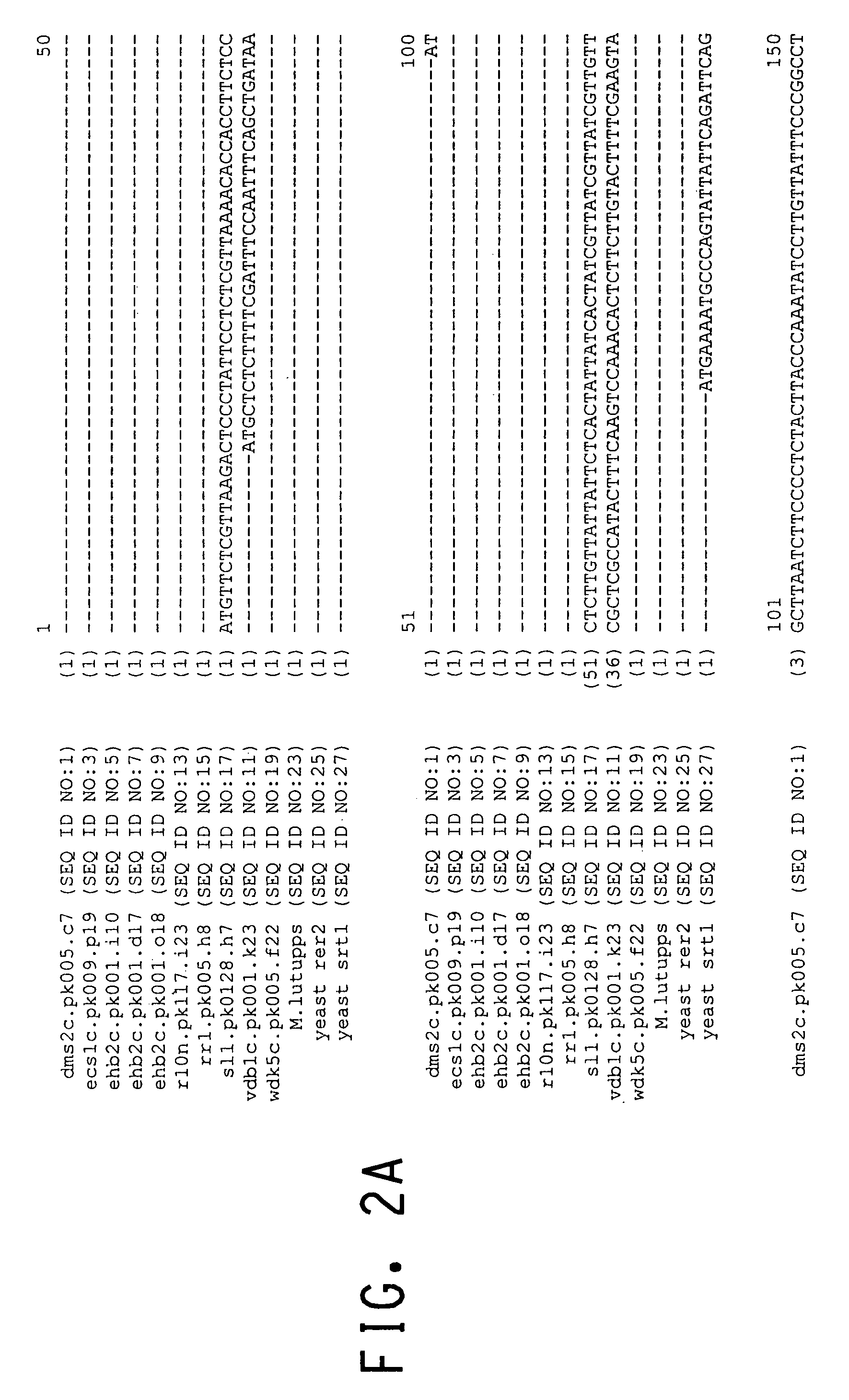Cis-prenyltransferases from plants
- Summary
- Abstract
- Description
- Claims
- Application Information
AI Technical Summary
Problems solved by technology
Method used
Image
Examples
example 1
Composition of cDNA Libraries Used for Identification of cDNA Clones from Plant Species Encoding cis-Prenyltransferase Homologs
[0127]cDNA libraries representing mRNAs from wheat, grape, soybean, rice, African daisy, rubber tree latex and marigold tissues were prepared. The characteristics of the libraries are described in Table 1. cDNA libraries were prepared by any one of several methods. The cDNAs were introduced into plasmid vectors by first preparing the cDNA libraries in Uni-ZAP XR vectors according to the manufacturer's protocol (Stratagene Cloning Systems, La Jolla, Calif.). The Uni-ZAP XR libraries were converted into plasmid libraries according to the protocol provided by Stratagene. Upon conversion, cDNA inserts were contained in the plasmid vector pBluescript. In an alternate approach the cDNAs were introduced directly into precut Bluescript II SK(+) vectors (Stratagene) using T4 DNA ligase (New England Biolabs), followed by transfection into DH10B cells according to the ...
example 2
Characterization of ESTs
[0129]ESTs encoding candidate cis-prenyltransferases were identified by conducting BLAST (Basic Local Alignment Search Tool; Altschul et al., J. Mol. Biol. 215:403-410 (1993); see also www.ncbi.nlm.nih.gov / BLAST / ) searches for similarity to sequences contained in the BLAST “nr” database (comprising all non-redundant GenBank CDS translations, sequences derived from the 3-dimensional structure Brookhaven Protein Data Bank, the last major release of the SWISS-PROT protein sequence database, EMBL and DDBJ databases). The cDNA sequences obtained in Example 3 were analyzed for similarity to all publicly available DNA sequences contained in the “nr” database using the BLASTN algorithm provided by the National Center for Biotechnology Information (NCBI). The DNA sequences were translated in all reading frames and compared for similarity to all publicly available protein sequences contained in the “nr” database using the BLASTX algorithm (Gish, W. and States, D. J. Na...
example 3
Identification and Characterization of cDNA Clones for cis-Prenyltransferases
[0130]cDNAs from the libraries listed in Table 1 were identified as cis-prenyltransferase homologs based on interrogation of the database described in Example s 1 and 2. cDNAs were thus identified by a number of methods, including the following: 1) keyword searches (e.g., “undecaprenyl”), 2) searches of the database using the TBLASTN algorithm provided by the National Center for Biotechnology Information (NCBI) and short fragments of conserved sequence present in bacterial undecaprenyl synthases, and 3) identification of further homologs of cDNAs discovered by 1 and 2 within the in-house database using the FASTA program. An alignment of the deduced amino acid sequence of the E. coli undecaprenyl pyrophosphate synthase gene with a number of other publicly-available sequences from bacteria, yeast (Saccharomyces cerevisiae) and one eukaryote (Caenorhabditis elegans) has been published (Apfel et al., J. Bacteri...
PUM
| Property | Measurement | Unit |
|---|---|---|
| Temperature | aaaaa | aaaaa |
| Fraction | aaaaa | aaaaa |
| Fraction | aaaaa | aaaaa |
Abstract
Description
Claims
Application Information
 Login to View More
Login to View More - R&D
- Intellectual Property
- Life Sciences
- Materials
- Tech Scout
- Unparalleled Data Quality
- Higher Quality Content
- 60% Fewer Hallucinations
Browse by: Latest US Patents, China's latest patents, Technical Efficacy Thesaurus, Application Domain, Technology Topic, Popular Technical Reports.
© 2025 PatSnap. All rights reserved.Legal|Privacy policy|Modern Slavery Act Transparency Statement|Sitemap|About US| Contact US: help@patsnap.com



